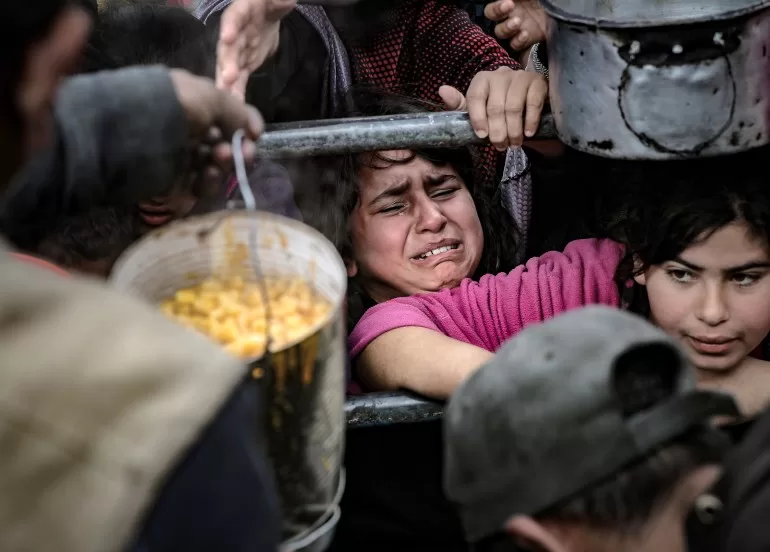In the streets, famine is a reality for nearly all the besieged population while the smell of death is ever-present.
With nearly no access to medical care, many are suffering from disease, while infection awaits tens of thousands of men, women and children injured by Israeli attacks.
Famine
Hunger has taken a heavy toll on everyone. With businesses and banking services either destroyed or unable to operate, there is no cash, no income and little to nothing to meet the cost of feeding their starving families.
With Gaza’s ability to produce its own food decimated by Israeli bombs, a hungry population looks for food from outside the Strip, provisions increasingly limited by Israel’s continuing blockade.
Agriculture is in ruins. Fertile areas such as Beit Hanoon, Beit Lahiya and Jabalia lie neglected, as winter rains, vital to farmers, fall unheeded. Poultry and livestock have also been destroyed, victims either directly or indirectly of the Israeli bombs.
Fish is a luxury lost to the coastal enclave’s population.
Famine is a growing reality. Few supplies are left and malnutrition is growing.
The international aid that does make it in can barely meet the needs of a hungry population, or prevent the situation from deteriorating.
Since the beginning of Israel’s ground offensive, many humanitarian agencies, like the United Nations Relief and Works Agency (UNRWA) have halted operations, meaning hundreds of thousands of people cannot access any aid.
The endless waves of bombing have destroyed Gaza’s infrastructure, razing or shuttering the factories producing and processing food.
About half the population of Gaza now faces daily shortages of bread, clean water and the basic ingredients for life.
In the east of Gaza, canned goods were once processed and bakeries seemed to stand on every street, they are now simply memories for the starving population.
As are meat and dairy. What food can be found is either extremely expensive or greatly reduced in quantity, often both.
The struggle extends beyond food. Water has become so scarce that contaminated drinking water has become the norm. As more people, especially children, consume polluted water, severe bacterial illnesses have thrived.
For those willing to risk falling buildings or bombs, firewood to boil water can be found, but cooking gas is a distant memory.
Disease
With uncooked food common, parents, desperate to feed their starving children, feel they have no option but to give them raw food, despite the consequences of doing so.
Across the Strip, infrastructure and sewage systems have been destroyed, resulting in a free flow of sewage that contributes to growing respiratory problems as a population weakened by hunger keeps breathing. Added to that is the smell of the dead, decomposing bodies of people and animals lying scattered in the streets or under rubble, polluting the air and raising the risk of disease transmission.
Medical facilities in Gaza have nearly all been destroyed, leaving those injured by Israeli attacks isolated and those with more complex or chronic needs, such as prenatal care or treatments like dialysis, without proper care.
In and around Gaza City, there are only two functioning hospitals: al-Shifa Hospital and Ahli Arab Hospital. In addition to struggling with many of the same circumstances as the rest of the Strip, they struggle with the demands of hundreds of thousands of injured and sick people calling for help.
The outcome is predictable. Thousands are slowly dying.
Without electricity, large numbers of the injured, the sick, premature newborn babies and those lying in intensive care units (ICUs) must all depend on oxygen pumped by machines reliant on generators, whose fuel supply is uncertain.
Everyone is at risk. Prenatal care units are out of service, increasing the risk of babies being born with health problems or complications.
Inevitably, as the bombing continues, the incidence of disease and the ever-present need for amputations rarely recedes.
All the while, the cold bites, affecting all.
Each day begins with a challenge of reaching its end.
In Gaza, sadly, that’s enough.








